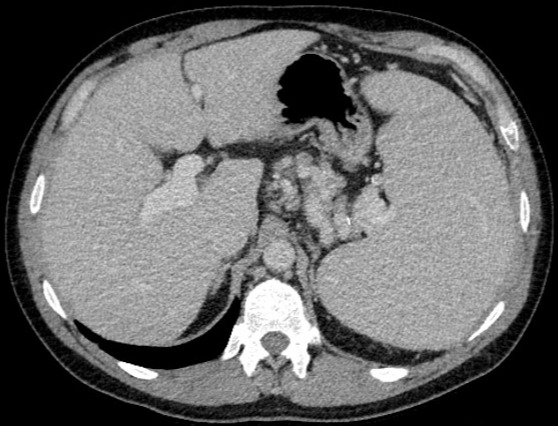Back


Poster Session C - Monday Afternoon
Category: Liver
C0610 - Massive Splenomegaly With Non-Cirrhotic Portal Hypertension
Monday, October 24, 2022
3:00 PM – 5:00 PM ET
Location: Crown Ballroom

Has Audio

Caroline Horne
Edward Via College of Osteopathic Medicine
Charlotte, NC
Presenting Author(s)
Leon W. Kundrotas, MD, MS1, Caroline Horne, 2
1Veterans Affairs Medical Center, Charlotte, NC; 2Edward Via College of Osteopathic Medicine, Charlotte, NC
Introduction: A 42 year old male with a 12 year history of Common Variable Immune Deficiency (CVID) presented for management of “cirrhosis.” His only subjective complaint was mild non-specific abdominal pain. He noted no history of jaundice, weight loss or constitutional symptoms. He did not drink alcohol. He was receiving immune globulin (Gamunex-C) infusions every 28 days.
Case Description/Methods: Physical exam revealed a middle aged male in no acute distress with stable VS with mild diffuse abdominal tenderness and “fullness." Remainder of exam was unremarkable. An abdominal CT scan was obtained that showed massive splenomegaly (Image 1), portal vein enlargement, no ascites. He had intact hepatic synthetic and excretory function, normal aminotransferases but an elevated alkaline phosphatase. An EGD done three years previously showed minimal esophageal varices. A transjugular liver biopsy was obtained that showed minimal hepatic fibrosis but features of nodular regenerative hyperplasia (NRH).
Discussion: CVID is the most common immunodeficiency disease with a prevalence of 1 in 25,000. It is a primary B-cell immunodeficiency disorder with hypogammaglobulinemia. It can occur at any age, without gender preference and can affect multiple organ systems to include the liver with hepatic fibrosis and portal hypertension. The most common hepatic dysfunction in CVID is nodular regenerative hyperplasia (NRH) occurring in 5-10% in this population. Depending on clinical practice patterns the gastroenterologist could be presented with this scenario de novo or in consultation with Allergy/Immunology or Infectious Disease subspecialties. NRH in this population has been divided into three categories: Category 1; non-progressive, Category 2; NRH with portal hypertension and splenomegaly (as in our case presentation) and Category 3; NRH with features of autoimmune hepatitis. Repeated hepatic cell injury with concurrent regeneration causing compression of hepatic parenchyma, or of the portal vein and central veins is thought to result in portal hypertension, esophageal varices and splenomegaly. The patient can present anywhere along this variable clinical spectrum of development. Biopsies typically show a lack of perinodular fibrosis or intrahepetic shunts. Category II patients despite immunoglobulin replacement, can have infectious complications due to neutropenia. Category III patients can be progressive. Awareness of this entity is essential to optimize treatment strategies.

Disclosures:
Leon W. Kundrotas, MD, MS1, Caroline Horne, 2. C0610 - Massive Splenomegaly With Non-Cirrhotic Portal Hypertension, ACG 2022 Annual Scientific Meeting Abstracts. Charlotte, NC: American College of Gastroenterology.
1Veterans Affairs Medical Center, Charlotte, NC; 2Edward Via College of Osteopathic Medicine, Charlotte, NC
Introduction: A 42 year old male with a 12 year history of Common Variable Immune Deficiency (CVID) presented for management of “cirrhosis.” His only subjective complaint was mild non-specific abdominal pain. He noted no history of jaundice, weight loss or constitutional symptoms. He did not drink alcohol. He was receiving immune globulin (Gamunex-C) infusions every 28 days.
Case Description/Methods: Physical exam revealed a middle aged male in no acute distress with stable VS with mild diffuse abdominal tenderness and “fullness." Remainder of exam was unremarkable. An abdominal CT scan was obtained that showed massive splenomegaly (Image 1), portal vein enlargement, no ascites. He had intact hepatic synthetic and excretory function, normal aminotransferases but an elevated alkaline phosphatase. An EGD done three years previously showed minimal esophageal varices. A transjugular liver biopsy was obtained that showed minimal hepatic fibrosis but features of nodular regenerative hyperplasia (NRH).
Discussion: CVID is the most common immunodeficiency disease with a prevalence of 1 in 25,000. It is a primary B-cell immunodeficiency disorder with hypogammaglobulinemia. It can occur at any age, without gender preference and can affect multiple organ systems to include the liver with hepatic fibrosis and portal hypertension. The most common hepatic dysfunction in CVID is nodular regenerative hyperplasia (NRH) occurring in 5-10% in this population. Depending on clinical practice patterns the gastroenterologist could be presented with this scenario de novo or in consultation with Allergy/Immunology or Infectious Disease subspecialties. NRH in this population has been divided into three categories: Category 1; non-progressive, Category 2; NRH with portal hypertension and splenomegaly (as in our case presentation) and Category 3; NRH with features of autoimmune hepatitis. Repeated hepatic cell injury with concurrent regeneration causing compression of hepatic parenchyma, or of the portal vein and central veins is thought to result in portal hypertension, esophageal varices and splenomegaly. The patient can present anywhere along this variable clinical spectrum of development. Biopsies typically show a lack of perinodular fibrosis or intrahepetic shunts. Category II patients despite immunoglobulin replacement, can have infectious complications due to neutropenia. Category III patients can be progressive. Awareness of this entity is essential to optimize treatment strategies.

Figure: Splenomegaly calculated volume of 2000 cc, engorged splenic vein
Disclosures:
Leon Kundrotas indicated no relevant financial relationships.
Caroline Horne indicated no relevant financial relationships.
Leon W. Kundrotas, MD, MS1, Caroline Horne, 2. C0610 - Massive Splenomegaly With Non-Cirrhotic Portal Hypertension, ACG 2022 Annual Scientific Meeting Abstracts. Charlotte, NC: American College of Gastroenterology.
